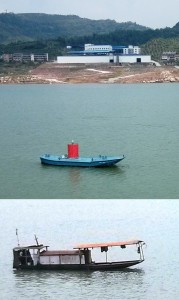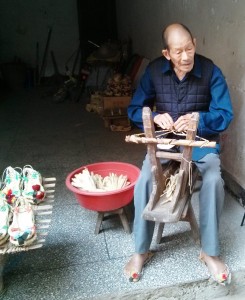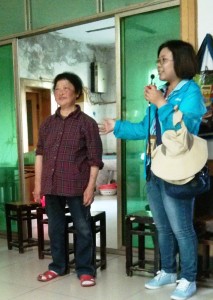There are pics today. Our first day’s cruise on the Yangtze River was quite relaxing. After two weeks of fairly high activity plus several days at high altitude, everybody was ready for a restful day. Our cruise ship is run by a US company. We were all delighted to find foods we are accustomed to. Chocolate is rare in China, and we haven’t found any peanut butter anywhere in the country. Our tour package includes the executive package — nicer rooms, nicer dining, wine with dinner, etc. It feels wonderful, especially after the rather primitive conditions we experienced in Tibet. There was an extra-cost tour in the morning. A few from our tour went on it and found it to be an interesting trip. But most of us made the most of a day of R & R.
We spent hours sitting on our balcony observing the world go by. They use unmanned boats as channel markers. Things have changed since “A Story of Ping”. A few sampans still sail these waters, but they use motors for propulsion and no longer have wise eyes. We didn’t see any ducks or boys tied to barrels. We attended a talk about the Yangtze River. From a commercial viewpoint, the Yangtze is the busiest river in the world. It is a little longer than the Mississippi, but carries twice the commercial traffic. “Ping” gives a peaceful picture of sailing down the river, but sailing the Yangtze was anything but peaceful in reality. Parts of the river, especially the 3 big gorges, had fast currents. Sailing downstream dangerous. One section was called “The gateway to hell”. There were a tow paths to pull boats upstream. They used human “tow trackers” to pull boats upstream. Boats required anywhere from 5 to 100 men. This was an extremely arduous and dangerous job with a high mortality rate. The men generally worked naked. (With some very clever photoshopping — women were not permitted to sit in the front of the boat.) The speaker said they used humans instead of animals because animals were more valuable, and humans more intelligent. Some of us in the audience questioned the second point. All of this changed with the building of the Three Gorges Dam.
We docked at 4:30 for tours. Most passengers visited the Red Pagoda. The Chinese wanted to preserve the Pagoda, but it was cost too much to move it. The hill the Pagoda sits on is above the high water mark, but the surrounding land is not. The solution was to build a levee around the pagoda hill, turning it into an island during the winter high water season. A pedestrian bridge give access.
Our group visited the village that lives along the river. This village was relocated to higher ground. The government gave the residents enough money to build new houses. The residents built the houses themselves or hired contractors to do it. Most houses are 4 stories high. There is a garage for storage at street level, then 3 levels for housing; one family per floor. The houses are large and modern. They have electricity, indoor plumbing, natural gas, air conditioning, etc. But these were farmers, and the land for farming is under water. They still farm small plots. The only industry is tourism. Villagers do crafts, work at the “Hello” market, work on the tour boats, or are retired. Their children leave the village to find jobs. The family we visited is typical. “Grandpa” is 90 and spends his days making sandals from corn leaves in the garage. “Mom and Dad” own the unit on the second floor. They are retired and draw 500 yuan/month from the government. Their two daughters have left town to find jobs. They take care of their younger 8-year old grandson. The daughter visits every 2 or 3 weeks to see her son. The rent one of their bedrooms for a nominal cost plus cooking services. When they get older, they will move in with their daughter and try to sell their house.



